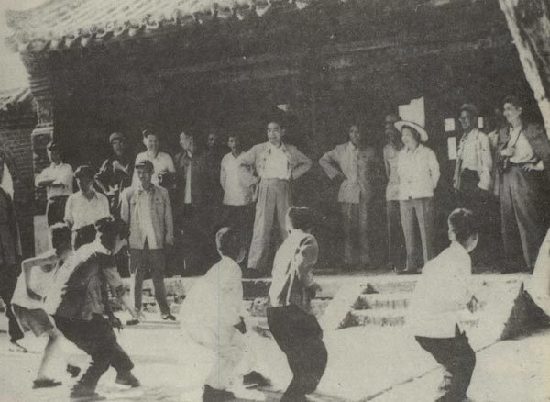CDMAA Traditional Levels of AttainmentMaster Chan Tin Sang (1924-1993) offered the following explanation of Hakka martial tradition, and an interesting adaptation for students living in the West. The CDMAA encourages all students of the martial arts to train diligently and honestly. The CDMAA does not use the coloured belt grading system, but encourages students to develop a healthy mind and body in the pursuit of inner and outer peace. As a consequence, training is an organic and an evolutionary process that cannot be limited to arbitrary grades – although the CDMAA acknowledges that grading systems are useful and helpful for some people. In the traditional Hakka village, sometimes people wore a cloth belt around their midriff as part of their ordinary clothing – usually for working in the fields to assist in supporting the inner organs of the body when bending or leaning forward during planting or harvesting. In the Chan Family Hakka village of Sai Kung (Hong Kong), an Assistant Instructor (to distinguish his or her martial authority) turned the knot of the belt from facing front (below the naval), to facing right (positioned on the right hip), and a Full Instructor (generally being an elder man or woman) removed the belt altogether (because at this advanced level of attainment, their martial ability would be well known within their community). As Western students do not generally wear Chinese-style belts or sashes as part of their ordinary clothing – an honorary black sash is awarded at Assistant Instructor level (worn with the knot to the right), however, as soon as the student archives Full Instructor – the black sash is removed and generally placed on a shrine as a spiritual ‘banner’. Master Chan Tin Sang taught that it is very difficult to achieve any of the Instructor ranks, because such an achievement involves a radical transformation of mind and body to such an extent, that being given a ‘black sash’ to wear should then be seen as an impediment to further development, and treated with a sense of ‘shame’ by those who have achieved it. It is better in training to continuously develop moment by moment and do not become distracted by striving for arbitrary and pointless designations. Some students in the past have ‘refused’ all formal acknowledgement of their inner and outer development – and it is these students that have eventually achieved mastery. Stay true to your inner journey and show perseverance in the outer world. In this way the virtuous martial arts student acts as an inspiration for the world.
1) Honoured Student (New Student) 2) Advanced Student (Five Years of Training) 3) Assistant Instructor (Ten Years of Training) 4) Full Instructor (15 Years of Training) 5) Master (20 Years of Training) 6) Grand Master (30 Years of Training) 7) Lineage Inheritor (Special Designation) 8) Basic Fitness Test (Open to All) 9) Permission to Wear the CDMAA Badge (Anyone who passes the Basic Fitness Test) Basic Fitness Test: The Basic Fitness is generally taken by a new student around 3 to 6 months into their training. A student can only take this test if they have developed strength and stamina in the Training Hall through regular attendance, have attained technical proficiency, and are able to defend themselves adequately during ungloved - but controlled - sparring sessions with more experienced practitioners. In general, the structure is as follows (but can vary depending upon individual need and circumstances): 3 minutes of skipping rope. 100 press-ups - 5 minutes or less. 100 sit-ups - 5 minutes or less. 100 back raises - 5 minutes or less. 100 squat kicks - 5 minutes or less. 100 reverse punches on a strike pad (50 on each arm) - 5 minutes or less. 100 round-kicks on strike pad (50 on each leg) - 5 minutes or less). 10 hard punches delivered to the abdomen of the student by Instructor. 3 minutes combination (kicking and punching) work on the heavy bag. 3 minutes blocking on Wooden Man. 3 minutes accuracy testing - String Form. 56Ibs rucksack hill run - 1.5 miles in 15 minutes or less. The Basic Fitness test is also applied in modified form to applicants who wish to take the 'Assistant Instructor' or 'Full Instructor' qualifications. |
